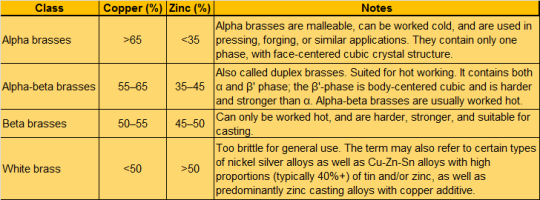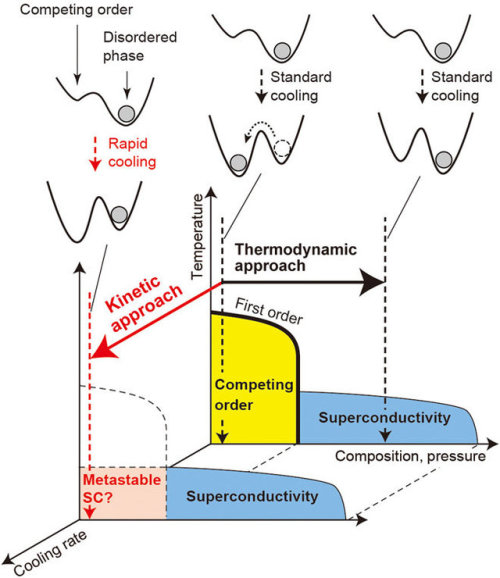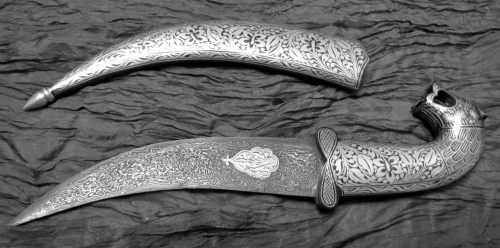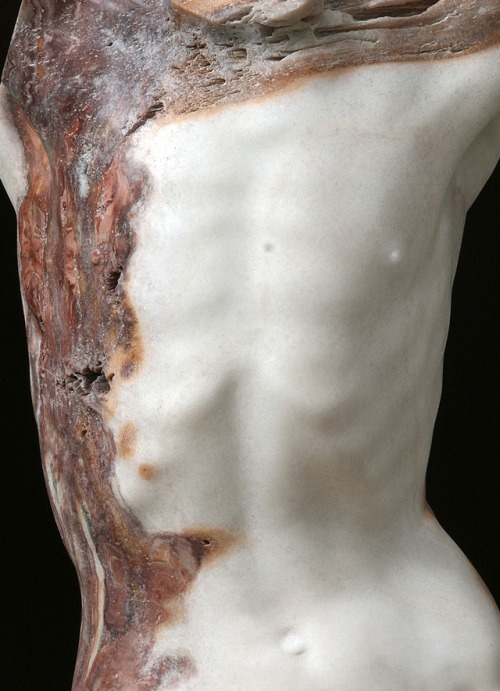#metals
Researchers present new strategy for extending ductility in a single-phase alloy
Simultaneous high strength and large ductility are always desirable for metallic materials. However, while the strength of metals and alloys can be easily increased by five to 15 times through simple plastic deformation or grain refinement down to the nano-scale, the gain in strength is usually accompanied by a drastic loss of uniform ductility. Ductility depends strongly on the work hardening ability, which becomes weak in materials with high strength, especially in a single-phase material.
Publishing online in PNAS, the research group of Prof. WU Xiaolei at the Chinese Academy of Sciences, in collaboration with Prof. En Ma at Johns Hopkins University, U.S., have demonstrated a strategy for exploiting a dynamically reinforced multilevel heterogeneous grain structure (HGS). They demonstrated the behavior of such an HGS using the face-centered-cubic CrCoNi medium-entropy alloy (MEA) as a model system.
Back stress hardening is usually not obvious in single-phase homogeneous grains. To overcome this, the scientists purposely created an unusually heterogeneous grain structure. They took advantage of the low stacking fault energy of the MEA, which facilitates the generation of twinned nano-grains and stacking faults during tensile straining, dynamically reinforcing the heterogeneity on the fly.
Post link
Forcing a metal to be a superconductor via rapid chilling
A team of researchers with the RIKEN Center for Emergent Matter Science and The University of Tokyo, both in Japan, has found a way to force a metal to be a superconductor by cooling it very quickly. In their paper published on the open access site, Science Advances, the group describes their process and how well it worked.
Scientists around the world continue to seek a material that behaves as a superconductor at room temperature—such a material would be extremely valuable because it would have zero electrical resistance. Because of that, it would not increase in heat as electricity passed through it, nor lose energy. Scientists have known that cooling some materials to very cold temperatures causes them to be superconductive. They have also known that some metals fail to do so because they enter a “competing state.” In this new effort, the researchers in Japan have found a way to get one such non-cooperative metal to enter a superconductive state anyway—and to stay that way for over a week.
Post link
Chameleon-Like Material Spiked With Boron Helps Bring Brain-Like Computing to Silicon Chips
Chameleon-Like Material Spiked With Boron Comes Closer To Mimicking Brain Cells
In a new study, Texas A&M researchers in the Department of Materials Science and Engineering describe a new material that comes close to mimicking how brain cells perform computations.
Each waking moment, our brain processes a massive amount of data to make sense of the outside world. By imitating the way the human brain solves everyday problems, neuromorphic systems have tremendous potential to revolutionize big data analysis and pattern recognition problems that are a struggle for current digital technologies.
But for artificial systems to be more brain-like, they need to replicate how nerve cells communicate at their terminals, called the synapses.
Post link
New process can extend lifetime of metals
Stronger, lighter, cheaper materials are the name of the game in advanced manufacturing. Keeping costs down on materials that are equally, if not more, effective than previous ones is how businesses get ahead—and, theoretically, when consumers win.
But what if stronger, lighter and cheaper means shorter lifetimes for materials used in automobiles? That’s the problem an international research team led by Western materials engineer Hamidreza Abdolvand tackled in a new study published by high-impact journals Acta Materialia and Communications Materials.
Abdolvand, along with Western Engineering graduate student Karim Louca and collaborators at the European Synchrotron Radiation Facility and Arts et Métiers ParisTech, discovered important factors contributing to the deformation (changing shape) of metals used in automobiles and nuclear reactors, and developed new models to predict the lifetimes of these materials.
Post link
High-throughput computer model predicts diffusion data for the transport of light elements within solids
The diffusion of light elements into metals has been efficiently modeled by A*STAR researchers using a machine learning approach.
Solid-state diffusion, in which atoms migrate through the lattice of a host material, underpins a variety of important processes that range from undesirable (corrosion) to useful (metal-joining processes). In one mechanism called ‘interstitial diffusion,“ light elements, such as nitrogen, move through lattices made up of much bigger atoms, such as metals, by squeezing between them. Yingzhi Zeng and colleagues at the A*STAR Institute of High Performance Computing have now developed a rapid predictive model for this phenomenon.
"Typical examples of interstitial diffusion include surface hardening of steel through carburization or nitridation, and the diffusion of oxygen in titanium for the design of implant and aerospace alloys,” Zeng says. This process is important to understand, but particularly difficult to probe experimentally. The challenge stems from the heavy-duty specialized equipment that is often required, and because as Zeng explains, “most experimental techniques rely on surface measurements, and so are inherently limited to a few nanometers under the surface.”
Post link
Just in time for the icy grip of winter: A team of researchers led by scientists from the U.S. Department of Energy Lawrence Berkeley National Laboratory (Berkeley Lab) has identified several mechanisms that make a new, cold-loving material one of the toughest metallic alloys ever. Nanoscale…
New composite materials prolong the service life of spare parts for equipment and vehicles
Studies have shown that hybrid powder materials based on natural layered silicates developed by the chemists of the Far Eastern Federal University (FEFU) and the Far Eastern Branch of the Russian Academy of Sciences (FEB RAS) decrease the friction ratio in metals sevenfold. These new materials offer new prospects for the development of more efficient anti-friction additives, increasing the durability of spare parts for equipment and vehicles.
The work was carried out by research associates of the School of Natural Sciences and Engineering School of FEFU, as well as the Institute of Chemistry of FEB RAS. The research running led by Nikolay Shapkin, professor of the Department of General, Inorganic, and Organoelement chemistry at FEFU. The results were published in Inorganic Materials.
The scientists report two hybrid composite materials based on natural layered silicates and plant products. The first was obtained from nontronite silicate isolated from Popov Island in the vicinity of Vladivostok and modified with alkaline rice husk hydrolysate. Experiments have shown that applying this powder reduces the deterioration of friction-producing parts 2.5 to seven times. Another material based on vermiculite from Karelia and modified with regular cellulose reduced the friction ratio 1.6 times.
Post link
Supermaterials out of the microwave
Using non-conventional methods, Christina Birkel and her colleagues in the Department of Chemistry of the TU Darmstadt produce metallic ceramics and new materials for the energy supply of the future.
The microwave oven in the laboratory of Christina Birkel, junior research group leader at the TU Darmstadt, is not only larger and significantly more expensive than the usual household device, but also more powerful and fire and explosion-proof. Birkel had the turntable and its plastic support removed. “That would have melted anyway,” she says. The chemist uses the oven for the synthesis of substances that experts call MAX phases. M stands for a transition metal, for example for titanium or vanadium, A for a main group element – usually aluminium – and X for carbon, and more rarely also nitrogen. Thus far, approximately 70 members of this family are known.
“Around the turn of the millennium, research efforts in the field of MAX phases have increased significantly,” explains Birkel. No wonder, because the materials are scratch-resistant, high-temperature stable and in many cases oxidation-resistant like a ceramic, but they also conduct electricity and sometimes have extraordinary magnetic proper ties. They are therefore also referred to as metallic ceramics. Similarly to clay minerals, MAX phases have a lamellar structure of alternating A and M-X-M layers.
Post link
Two Great Innovations: Floating Metal&Super Glass
Researchers have created a metal “foam” that is lighter than water. Ships made of it would float even with a hull breach. But that’s not too likely bc the metal is also very strong, able to withstand 25,000 psi, and the structure of the foam also acts a shock absorber.
Needless to say, this can have a lot applications, especially for machinery intended for aquatic environments.Researchers have also created a new type of glass film that is both superhydrophobic (water will literally bounce off of it), much like water on lotus leaves - as well as substantially reducing reflective glare, much like moth corneas.
Their innovation will have wide ranging benefits, but perhaps most excitingly for solar panels. As the article notes:the suppression of reflected light translates into a 3-6 percent relative increase in light-to-electricity conversion efficiency and power output of the cells. Coupled with the superhydrophobic self-cleaning ability, this could also substantially reduce maintenance and operating costs of solar panels. In addition, the coating is highly effective at blocking ultraviolet light.
The self-cleaning is due to water bouncing off the panels - taking dirt and debris with it.
Post link
Additive Manufacturing: Directed Energy Deposition
A type of metal additive manufacturing process, directed energy deposition (DED) uses either powders or wires to create finished parts. Unlike most other AM processes, DED is commonly used to repair components or add additional material, rather than simply create new parts.
Types of directed energy deposition, or other names for the process, include directed metal deposition (DMD), laser metal deposition (LMD), laser-engineered net shaping (LENS), and laser consolidation (LC).
DED uses a deposition head to feed either powder or wire into a laser (or electron) beam that melts the material, thereby building up the surface of the part. Because it is not melting material that has already been laid down (such as in powder bed fusion), DED can build on existing parts. Powders can also be mixed, utilizing different material properties. Using different, compatible materials can increase wear, corrosion, and oxidation resistance, one of the benefits of DED.
Limited in size only by the beam manipulation system, another benefit is that DED can produce relatively large parts, as shown in the top right image above: Sciaky (a US 3D printing company) can make 5-meter-large parts in a variety of different materials. Because of the method of deposition, there is also little to no waste involved. However, DED is also a relatively slow process, which takes much longer than other methods to produce parts.
Sources: ( 1 - image 1 ) ( 2 - image 3 ) ( 3 - images 2 and 4 ) (4)
Post link
Improving earthquake resistance with a single crystal
A new heating method for certain metals could lead to improved earthquake-resistant construction materials.
Tohoku University researchers and colleagues have found an economical way to improve the properties of some ’shape memory’ metals, known for their ability to return to their original shape after being deformed. The method could make way for the mass production of these improved metals for a variety of applications, including earthquake-resistant construction materials.
Most metals are made of a large number of crystals but, in some cases, their properties improve when they are formed of a single crystal. However, single-crystal metals are expensive to produce.
Researchers have developed a cheaper production method that takes advantage of a phenomenon known as ‘abnormal grain growth.’ By using this method, a metal’s multiple 'grains’, or crystals, grow irregularly, some at the expense of others, when it is exposed to heat.
The team’s technique involves several cycles of heating and cooling that results in a single-crystal metal bar 70 centimetres in length and 15 millimetres in diameter. This is very large compared to the sizes of current shape memory alloy bars, making it suitable for building and civil engineering applications, says Toshihiro Omori, the lead researcher in the study.
Post link
Tripling the efficiency of solar-based hydrogen fuel generation with metallic nanostructures that slow down light
Hydrogen gas, an important synthetic feedstock, is poised to play a key role in renewable energy technology; however, its credentials are undermined because most is currently sourced from fossil fuels, such as natural gas. A KAUST team has now found a more sustainable route to hydrogen fuel production using chaotic, light-trapping materials that mimic natural photosynthetic water splitting.
The complex enzymes inside plants are impractical to manufacture, so researchers have developed photocatalysts that employ high-energy, hot electrons to cleave water molecules into hydrogen and oxygen gas. Recently, nanostructured metals that convert solar electrons into intense, wave-like plasmon resonances have attracted interest for hydrogen production. The high-speed metal plasmons help transfer carriers to catalytic sites before they relax and reduce catalytic efficiency.
Getting metal nanoparticles to respond to the entire broadband spectrum of visible light is challenging. “Plasmonic systems have specific geometries that trap light only at characteristic frequencies,” explains Andrea Fratalocchi, who led the research. “Some approaches try to combine multiple nanostructures to soak up more colors, but these absorptions take place at different spatial locations so the sun’s energy is not harvested very efficiently.”
Post link
Scientists move graphene closer to transistor applications
Scientists at the U.S. Department of Energy’s Ames Laboratory were able to successfully manipulate the electronic structure of graphene, which may enable the fabrication of graphene transistors— faster and more reliable than existing silicon-based transistors.
The researchers were able to theoretically calculate the mechanism by which graphene’s electronic band structure could be modified with metal atoms. The work will guide experimentally the use of the effect in layers of graphene with rare-earth metal ions “sandwiched” (or intercalated) between graphene and its silicon carbide substrate. Because the metal atoms are magnetic the additions can also modify the use of graphene for spintronics.
“We are discovering new and more useful versions of graphene,” said Ames Laboratory senior scientist Michael C. Tringides. “We found that the placement of the rare earth metals below graphene, and precisely where they are located, in the layers between graphene and its substrate, is critical to manipulating the bands and tune the band gap.”
Post link
WOOTZ-DAMASCUS STEEL: A BRIEF INTRODUCTION
with sources
What is Damascus steel?
“Damascus steel” is the name given to a type of steel historically produced in the Middle East and in India. It was first produced in India, sometime in 200 B.C. Initially referred to as “Wootz” steel, returning Crusaders named the steel blades after the ironworking center. Damascus blades were held in near-mythical regard, being sharper and more resilient than any blade produced in the West. A characteristic trait of Wootz-Damascus steel was its bands of light and dark metal, called “watering,” “firind” or ”jawhar.” A historical example of Wootz-Damascus steel:
Wootz and Damascus steel are the same materal. Both the Middle East and India produced ingots and forged them. The notion that India only produced ingots, which were then traded to the Middle East and then forged is nonsense.
However, there is a difference between Wootz-Damascus steel and “faux-Damascus.” Faux-Damascus is simply pattern-welded (see below for an explanation) steel which maintains the characteristic light/dark bands of steel, but does not have the extraordinary material properties of true Wootz-Damascus steel. An example of modern, faux-Damascus:Wootz-Damascus steel was lost in the middle east sometime in the 18th Century, but the practice hung on India into the 19th Century. The steel was produced until the destabilization and destruction caused by British colonization.
How was Wootz-Damascus made?
Forging steel is an incredibly complex process. Wootz-Damascus steel relies on several factors:
a) a proper crucible forge, and extremely fine temperature control
b) specific ores which contained choice impurities, like molybdenum, vanadium, tungsten, phosphorus and others. In the same way that carbon can be added to iron to make it stronger, other, smaller elements will increase the strength of steel furtherand
c) a specific, lost technique of using natural materials like leaves and wood biomass to carburize the iron, adding carbon microstructures to the microscopic structure of the steel matrix.
Pattern-welding is often associated with Wootz-Damascus steel, but is not actually a part of the process. Pattern-welding is the practice of taking two different types of steel, placing them in alternating bars, then heating the bundle together and folding and twisting the metals together as they are hot-worked. This produces a spiral pattern reminiscent of Damascus steel. However, pattern-welded steel is inferior to both true Wootz-Damascus steel and 19th Century European homogeneous steel.
Why was Damascus steel feared and respected?
Source 1 and Source 2 for the following:
Wootz-Damascus steel displayed a combination of hardness and flexibility which seemed impossible to ironworkers of the time. Iron, by itself, is very soft and does not hold an edge well. However, if carbon is added to iron during forging, the iron becomes denser and harder, creating steel. However, as you add more carbon, the steel becomes harder and harder until it is so brittle it will simply break when struck upon something.
These two properties are inversely proportional, so in normal steel working you must settle on a mix of hardness and ductility that best suits your needs.
However, Wootz-Damascus steel is both superplastic and extremely hard. The structure of Wootz-Damascus steel contains two types of steel - a soft steel called ferrite and an extremely hard steel called cementite (Fe3C). Steel can actually be many different allotropes of steel, all of which are differentiated by their internal micro-structure. Consulting a phase diagram for iron and carbon:
The left axis is temperature, and the bottom axis is carbon content. As you increase temperature, or increase carbon content, the types of allotropes produced varies. All Wootz-Damascus examined so far is hyper-eutectoid, that is, it contains from about 1% to 2% carbon content. This is an extremely high carbon content, and would be useless for weapons if produced by European blacksmiths. They had no way of tempering the extreme brittleness of cementite. All European weapons were in or near the hypo-eutectoid range (less than .83% carbon content).
The secret to Wootz-Damascus steel lies both in its ore and in its carburization process.
Judging from the composition of historical Wootz-Damascus steel blades, the ore used by Middle Eastern and Indian metalsmiths contained trace amounts of other elements, such as molybdenum, vanadium, and tungsten. In modern times, such elements are used in steel production to produce stronger steels. Adding impurities into iron works because iron atoms are so large there is “room” for smaller atoms to be shoved into the crystalline structure:
The above image is for carbon atoms, however, elements like vanadium and tungsten are smaller than carbon atoms, so can be fitted into the crystalline structure even in the presence of carbon, filling in whatever else is left. Testing has shown that vanadium traces as low as 40 parts per million are enough to significantly alter the structure of the steel as a whole, creating cementite bands and cords. By having the cementite allotropes cluster together in bands, it helps to strengthen the material, also aiding in creating the characteristic waves and patterns.
By far the most significant process used was that of carburization. In usual terms, carburization is a hardening technique which heats metal in the presence of some carbon rich material, the carbon is then found on the surface of the metal, hardening it. Wootz-Damascus carburization produced an entirely different result, however.
Wootz-Damascus steel contains carbon nanotubes, a material that was only recently invented in the last two decades. Carbon nanotubes are a special type of carbon allotrope where carbon atoms bond in a peculiar tube formation, with a dominating hexagonal pattern:
Carbon nanotubes have a wide variety of strange and extraordinary properties, but the properties most significant to the production of Wootz-Damascus are its hardness, elastic, and strength.
Carbon nanotubes are the strongest materials currently known to man, both in terms of tensile strength and elasticity. This means they can bend and flex without breaking easily. However, they are also extremely hard, the bulk modulus of carbon nanotubes exceeds that of even diamonds (460+ GPa for carbon nanotubes vs. 420 GPa for a diamond). This means that carbon nanotubes display an unprecedented combination of both strength and flexibility, which is something that pure steel cannot even come close to replicating.
Nanotubes observed in a 17th Century Middle Eastern Sabre are found to encompass the cementite cords - the allotrope of steel which is usually too fragile to be used in weapons. The carbon nanotubes act as a sheath, reinforcing the cementite cords, allowing it to be both strong and malleable. The mythic properties of Wootz-Damascus steel are derived from this extraordinary and amazing steel structure.
It must be noted that modern carbon nanotubes are produced using expensive and advanced methods, such as using high amperage arcs of electricity, plasma torches, or pulsed lasers. Somehow, ancient metalworkers were able to produce carbon nanotubes using a specific blend of ores, woody biomass, and leaves, treated and forged in an process unfortunately lost to modern engineers.
Post link
Metal Made Like Plastic May Have Big Impact
Open a door and watch what happens – the hinge allows it to open and close, but doesn’t permanently bend. This simple concept of mechanical motion is vital for making all kinds of movable structures, including mirrors and antennas on spacecraft. Material scientists at NASA’s Jet Propulsion Laboratory in Pasadena, California, are working on new, innovative methods of creating materials that can be used for motion-based mechanisms.When a device moves because metal is flexing but isn’t permanently deformed, that’s called a compliant mechanism. Compliant mechanisms are all around us – in springs, surgical instruments, paperclips, clothespins and even micro-devices.
Researchers at JPL, Brigham Young University in Provo, Utah, and the California Institute of Technology in Pasadena, describe a new methodology for creating complex, low-cost compliant mechanisms using a combination of novel materials and manufacturing techniques in a recent paper featured on the cover of the journal Advanced Engineering Materials. They demonstrate that materials called “bulk metallic glasses” have highly desirable properties for these mechanisms. These “glasses,” as the scientists call them, are metal alloys designed to have a random arrangement of atoms.
Post link
Twin discoveries, ‘eerie’ effect may lead to manufacturing advances
The discovery of a previously unknown type of metal deformation – sinuous flow – and a method to suppress it could lead to more efficient machining and other manufacturing advances by reducing the force and energy required to process metals.
Researchers at Purdue University discovered sinuous flow deformation and also were surprised to discover a potentially simple way to control it, said Srinivasan Chandrasekar, a professor of industrial engineering, who is working with W. Dale Compton, the Lillian M. Gilbreth Distinguished Professor Emeritus of Industrial Engineering, postdoctoral research associate Ho Yeung and graduate student Koushik Viswanathan.
The team discovered the phenomenon by using high-speed microphotography and analysis to study what happens while cutting ductile metals. They found that the metal is deformed into folds while it is being cut – contrary to long-held assumptions that metals are sheared uniformly – and also that sinuous flow can be controlled by suppressing this folding behavior.
“When the metal is sheared during a cutting process it forms these finely spaced folds, which we were able to see for the first time only because of direct observation in real time,” Yeung said.
Post link
Alloys: Brass
An alloy of copper and zinc that has been known about since ancient times, brass is stronger and more durable than its base components, though not as strong as steel. It has stuck around for so long because it’s easy to work with, though the malleability depends upon the zinc content, and is used in decorations and applications where low friction is required.
Brass is a substitutional alloy, typically composed of around 67% copper and 33% zinc. Alloys with less zinc are occasionally called red brass while alloys with more zinc (above 45%) are known as white brasses (and are not commonly used industrially). The table below shows some of the common classifications.

Other elements commonly added to brass include tin, iron, arsenic, antimony, aluminum and potentially small amounts of manganese, silicon, and phosphorus. Lead is also a common additive, though it is becoming less common thanks to growing concerns about its toxicity.
Aside from the properties mentioned above there are many more reasons why brass is a desirable metal. The high copper content makes brass anti-microbial, making it ideal for use in commonly touched items. Brass is also fairly corrosion resistant, allowing it to be used in plumbing. Instruments made of brass are also extremely common thanks to the alloys workability and durability.
Check out this link for a list of common brass alloys and this one for more in depth information on the properties of various alloys.
Image Sources: Top left,top right,middle left,middle right,bottom left,bottom right
Post link
Catalysts are extremely important in variety of fields of industry, especially in energy sector. However, nowadays they are mostly made from platinum – one of the scarcest metals in the Earth’s crust. This means that production of them is rather expensive and difficult. But now scientists a…
The Effects of Hot Isostatic Pressing of Platinum Alloy Castings on Mechanical Properties and Microstructures http://www.technology.matthey.com/article/59/3/207-217/
Post link
































